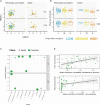Potential Association Between Dietary Fibre and Humoral Response to the Seasonal Influenza Vaccine
- PMID: 34868014
- PMCID: PMC8635806
- DOI: 10.3389/fimmu.2021.765528
Potential Association Between Dietary Fibre and Humoral Response to the Seasonal Influenza Vaccine
Abstract
Influenza vaccination is an effective public health measure to reduce the risk of influenza illness, particularly when the vaccine is well matched to circulating strains. Notwithstanding, the efficacy of influenza vaccination varies greatly among vaccinees due to largely unknown immunological determinants, thereby dampening population-wide protection. Here, we report that dietary fibre may play a significant role in humoral vaccine responses. We found dietary fibre intake and the abundance of fibre-fermenting intestinal bacteria to be positively correlated with humoral influenza vaccine-specific immune responses in human vaccinees, albeit without reaching statistical significance. Importantly, this correlation was largely driven by first-time vaccinees; prior influenza vaccination negatively correlated with vaccine immunogenicity. In support of these observations, dietary fibre consumption significantly enhanced humoral influenza vaccine responses in mice, where the effect was mechanistically linked to short-chain fatty acids, the bacterial fermentation product of dietary fibre. Overall, these findings may bear significant importance for emerging infectious agents, such as COVID-19, and associated de novo vaccinations.
Keywords: fibre; influenza; microbiome; short chain fatty acids (SCFA); vaccine.
Copyright © 2021 Cait, Mooney, Poyntz, Shortt, Jones, Gestin, Gell, Grooby, O’Sullivan, Tang, Young, Thayabaran, Sparks, Ostapowicz, Tay, Poppitt, Elliott, Wakefield, Parry-Strong, Ralston, Beasley, Weatherall, Braithwaite, Forbes-Blom and Gasser.
Conflict of interest statement
SE and GW were employed by Food Savvy. The remaining authors declare that the research was conducted in the absence of any commercial or financial relationship that could be construed as a potential conflict of interest.
Figures




References
Publication types
MeSH terms
Substances
LinkOut - more resources
Full Text Sources
Medical

